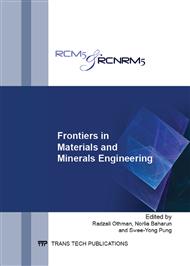[1]
K. L. Kadam, L. H. Forrest and W. A. Jacobson, Rice straw as a lignocellulosic resource: collection, processing, transportation, and environmental aspects, Biomass and Bioenergy, 18, 369-389 (2000).
DOI: 10.1016/s0961-9534(00)00005-2
Google Scholar
[2]
N. T. K. Oanh, B. T. Ly, D. Tipayarom, B. R. Manandhar, P. Prapat, C. D. Simpson and L. -J. Sally Liu, Characterization of particulate matter emission from open burning of rice straw, Atmospheric Environment, 45, 493-502 (2011).
DOI: 10.1016/j.atmosenv.2010.09.023
Google Scholar
[3]
T. Suramaythangkoor and S. H. Gheewala, Potential alternatives of heat and power technology application using rice straw in Thailand, J. Applied Energy 87, 128-133 (2010).
DOI: 10.1016/j.apenergy.2009.06.018
Google Scholar
[4]
Y. Matsumura, T. Minowa and H. Yamamoto, Amount, availability, and potential use of rice straw (agricultural residue) biomass as an energy resource in Japan, Biomass and Bioenergy, 29, 347-354 (2005).
DOI: 10.1016/j.biombioe.2004.06.015
Google Scholar
[5]
B. Gadde, C. Menke, and R. Wassmann, Rice straw as a renewal energy source in India, Thailand, and the Philippines: Overall potential and limitations for energy contribution and greenhouse gas mitigation, J. Biomass and Bioenergy, 33, 1532-1546 (2009).
DOI: 10.1016/j.biombioe.2009.07.018
Google Scholar
[6]
M. K. Delivand, M. Barz, S. H. Gheewala and B. Sajjakulnukit, Economic feasibility assessment of rice straw utilization for electricity generating through combustion in Thailand, J. Applied Energy, 88, 3651-3658 (2011).
DOI: 10.1016/j.apenergy.2011.04.001
Google Scholar
[7]
J. Park, E. Kanda, A. Fukushima, K. Motobayashi, K. Nagata, M. Kondo, Y. Ohshita, S. Morita and K. Tokuyasu, Contents of various sources of glucose and fructose in rice straw, a potential feedstock for ethanol production in Japan, J. Biomass and Bioenergy, 35, 3733-3735. (2011).
DOI: 10.1016/j.biombioe.2011.05.032
Google Scholar
[8]
P. Binod, R. Sindhu, R. R. Singhania, S. S. Nagalakshmi, N. Kurien, R. K. Sukumaran and A. Pandey, Bioethanol production from rice straw: An overview, J. Bioresource Technology, 101, 4767-4774. (2010).
DOI: 10.1016/j.biortech.2009.10.079
Google Scholar
[9]
P. W. McMillan, Glass-ceramics. Nelson Research Laboratories English Electric Co. Ltd. Stafford, London, pg. 1, 39, 61-71, 94-95, 127, 155. (1964).
Google Scholar
[10]
R. D. Rawlings, J. P. Wu and A. R. Boccaccini, Glass-ceramics: Their production from wastes – A Review, J. Mater Sci., 41, 733-761. (2006).
DOI: 10.1007/s10853-006-6554-3
Google Scholar
[11]
Z. Abdul Wahab, S. Zaibon, K. A. Matori, N. H. Edros, M. Y. Thai, M. Z. H. Mayzan, M.S. Mohd Ghazali and M. N. Md Daud, Preparation and characterization of glass-ceramic synthesized from soda lime glass and wastewater sludge, Pertanika J. Sci. & Technol., 18 (2) 223-229. (2010).
Google Scholar
[12]
R. R. Zaky, M. M. Hessien, A. A. El-Midany, M. H. Khedr, E. A. Abdel-Aal and K. A. El-Barawy, Preparation of silica nanoparticles from semi-burned rice straw ash, Powder Technology, 185, 31-35. (2008).
DOI: 10.1016/j.powtec.2007.09.012
Google Scholar
[13]
Z. Strnad, Glass-Ceramic Materials – Glass Science and Technology 8. (Elsevier Science Publishing Company, Inc. New York) p.167. (1986).
Google Scholar
[14]
P. F. James, Volume nucleation in silicate glasses, In: Glasses & Glass-Ceramics, edited by M. H. Lewis, Chapman and Hall, New York, p.88 (1989).
DOI: 10.1007/978-94-009-0817-8_3
Google Scholar
[15]
A. Karamanov and M. Pelino, Evaluation of the degree of crystallisation in glass-ceramics by density measurements,. Journal of the European Ceramic Society, 19, 649-654 (1998).
DOI: 10.1016/s0955-2219(98)00226-x
Google Scholar


